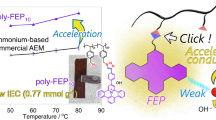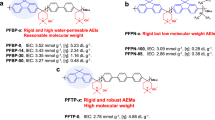Abstract
Trifluoromethanesulfonylimide-grafted polybenzimidazole (PBI-TFSI) was synthesized for proton exchange membrane (PEM) applications. Its proton conductivity was (a) less dependent on humidity and (b) higher than that of conventional fluorine-based PEM (Nafion) and propanesulfonic acid-grafted PBI (PBI-PS) at a relative humidity of 40%. The chemical structure of PBI-TFSI was investigated using 1H and 19F nuclear magnetic resonance and Fourier transform infrared spectroscopy. The membranes exhibited good transparency, flexibility, and thermal stability up to 350 °C. Membranes with different side chain grafting ratios were prepared, and the water uptake and hydration number of the PBI-TFSI membranes were lower than those of the PBI-PS membranes, most likely because of the hydrophobicity of the side chain. The higher proton concentration provided by TFSI with stronger acidity than PS might be the reason for the higher proton conductivities of PBI-TFSI.
This is a preview of subscription content, access via your institution
Access options
Subscribe to this journal
Receive 12 print issues and online access
$259.00 per year
only $21.58 per issue
Buy this article
- Purchase on Springer Link
- Instant access to full article PDF
Prices may be subject to local taxes which are calculated during checkout







Similar content being viewed by others
References
Liu Y-L. Developments of highly proton-conductive sulfonated polymers for proton exchange membrane fuel cells. Polym Chem. 2012;3:1373–83.
Byun GH, Kim JA, Kim NY, Cho YS, Park CR. Molecular engineering of hydrocarbon membrane to substitute perfluorinated sulfonic acid membrane for proton exchange membrane fuel cell operation. Materials Today. Energy. 2020;17:100483.
Shin DW, Guiver MD, Lee YM. Hydrocarbon-based polymer electrolyte membranes: importance of morphology on ion transport and membrane stability. Chem Rev. 2017;117:4759–805.
Escorihuela J, Olvera-Mancilla J, Alexandrova L, del Castillo LF, Compañ V. Recent progress in the development of composite membranes based on polybenzimidazole for high temperature proton exchange membrane (PEM) fuel cell applications. Polymers. 2020;12:1861.
Houchins C, Kleen GJ, Spendelow JS, Kopasz J, Peterson D, Garland NL, et al. DOE progress towards developing low-cost, high performance, durable polymer electrolyte membranes for fuel cell applications. Membranes. 2012;2:855–78.
Kusoglu A, Weber AZ. New insights into perfluorinated sulfonic-acid ionomers. Chem Rev. 2017;117:987–1104.
Cooper KR. Progress toward accurate through-plane ion transport resistance measurement of thin solid electrolytes. J Electrochem Soc. 2010;157:B1731.
Li N, Guiver MD. Ion transport by nanochannels in ion-containing aromatic copolymers. Macromolecules. 2014;47:2175–98.
Ghosh A, Banerjee S. Sulfonated fluorinated-aromatic polymers as proton exchange membranes. e-Polym. 2014;14:227–57.
Lochner T, Kluge RM, Fichtner J, El-Sayed HA, Garlyyev B, Bandarenka AS. Temperature effects in polymer electrolyte membrane fuel cells. ChemElectroChem. 2020;7:3545–68.
Xiao P, Li J, Tang H, Wang Z, Pan M. Physically stable and high performance Aquivion/ePTFE composite membrane for high temperature fuel cell application. J Membr Sci. 2013;442:65–71.
Economou NJ, Barnes AM, Wheat AJ, Schaberg MS, Hamrock SJ, Buratto SK. Investigation of humidity dependent surface morphology and proton conduction in multi-acid side chain membranes by conductive probe atomic force microscopy. J Phys Chem B. 2015;119:14280–87.
Bae B, Miyatake K, Watanabe M. Effect of the Hydrophobic Component on the Properties of Sulfonated Poly(arylene ether sulfone)s. Macromolecules. 2009;42:1873–80.
Chang Y, Brunello GF, Fuller J, Disabb-Miller ML, Hawley ME, Kim YS, et al. Polymer electrolyte membranes based on poly(arylene ether sulfone) with pendant perfluorosulfonic acid. Polym Chem. 2013;4:272–81.
Na T, Shao K, Zhu J, Sun H, Liu Z, Zhao C, et al. Block sulfonated poly(arylene ether ketone) containing flexible side-chain groups for direct methanol fuel cells usage. J Membr Sci. 2012;417-418:61–68.
Liu S, Luo W, Zhang H, Li X, Hu W, Guiver MD, et al. Novel iodo-containing poly(arylene ether ketone)s as intermediates for grafting perfluoroalkyl sulfonic acid groups. React Funct Polym. 2017;111:7–13.
Shiino K, Miyake J, Miyatake K. Highly stable polyphenylene ionomer membranes from dichlorobiphenyls. Chem Commun. 2019;55:7073–76.
Ahmed F, Sutradhar SC, Ryu T, Jang H, Choi K, Yang H, et al. Comparative study of sulfonated branched and linear poly(phenylene)s polymer electrolyte membranes for fuel cells. Int J Hydrog Energy. 2018;43:5374–85.
Aili D, Henkensmeier D, Martin S, Singh B, Hu Y, Jensen JO, et al. Polybenzimidazole-based high-temperature polymer electrolyte membrane fuel cells: new insights and recent progress. Electrochem. Energ. Rev. 2020;3:793–845.
Aili D, Yang J, Jankova K, Henkensmeier D, Li Q. From polybenzimidazoles to polybenzimidazoliums and polybenzimidazolides. J Mater Chem A. 2020;8:12854–86.
Li X, Ma H, Wang P, Liu Z, Peng J, Hu W, et al. Highly conductive and mechanically stable imidazole-rich cross-linked networks for high-temperature proton exchange membrane fuel cells. Chem Mater. 2020;32:1182–91.
Yang JS, Cleemann LN, Steenberg T, Terkelsen C, Li QF, Jensen JO, et al. High molecular weight polybenzimidazole membranes for high temperature PEMFC. Fuel Cells. 2014;14:7–15.
Oono Y, Sounai A, Hori M. Long-term cell degradation mechanism in high-temperature proton exchange membrane fuel cells. J Power Sources. 2012;210:366–73.
Kreuer K-D. Ion conducting membranes for fuel cells and other electrochemical devices. Chem Mater. 2014;26:361–80.
Lee K-S, Spendelow JS, Choe Y-K, Fujimoto C, Kim YS. An operationally flexible fuel cell based on quaternary ammonium-biphosphate ion pairs. Nat Energy. 2016;1:16120.
Yamaguchi I, Osakada K, Yamamoto T. Introduction of a long alkyl side chain to poly(benzimidazole)s. N-alkylation of the imidazole ring and synthesis of novel side chain polyrotaxanes. Macromolecules. 1997;30:4288–94.
Kumbharkar SC, Kharul UK. N-substitution of polybenzimidazoles: synthesis and evaluation of physical properties. Eur Polym J. 2009;45:3363–71.
Bhavsar RS, Kumbharkar SC, Rewar AS, Kharul UK. Polybenzimidazole based film forming polymeric ionic liquids: synthesis and effects of cation–anion variation on their physical properties. Polym Chem. 2014;5:4083–96.
Kawahara M, Rikukawa M, Sanui K, Ogata N. Synthesis and proton conductivity of sulfopropylated poly(benzimidazole) films. Solid State Ion. 2000;136-137:1193–96.
Bae JM, Honma I, Murata M, Yamamoto T, Rikukawa M, Ogata N. Properties of selected sulfonated polymers as proton-conducting electrolytes for polymer electrolyte fuel cells. Solid State Ion. 2002;147:189–94.
Kulkarni MP, Peckham TJ, Thomas OD, Holdcroft S. Synthesis of highly sulfonated polybenzimidazoles by direct copolymerization and grafting. J Polym Sci Part A. 2013;51:3654–66.
Rozière J, Jones DJ, Marrony M, Glipa X, Mula B. On the doping of sulfonated polybenzimidazole with strong bases. Solid State Ion. 2001;145:61–68.
Jouanneau J, Mercier R, Gonon L, Gebel G. Synthesis of sulfonated polybenzimidazoles from functionalized monomers: preparation of ionic conducting membranes. Macromolecules. 2007;40:983–90.
Koppel IA, Taft RW, Anvia F, Zhu S-Z, Hu L-Q, Sung K-S, et al. The gas-phase acidities of very strong neutral bronsted acids. J Am Chem Soc. 1994;116:3047–57.
Chandra Sutradhar S, Rahman MM, Ahmed F, Ryu T, Jin L, Yoon S, et al. Improved proton conductive membranes from poly(phenylenebenzophenone)s with pendant sulfonyl imide acid groups for fuel cells. J Power Sources. 2019;442:227233.
Sutradhar SC, Rahman MM, Ahmed F, Ryu T, Yoon S, Lee S, et al. Thermally and chemically stable poly(phenylenebenzophenone) membranes for proton exchange membrane fuel cells by Ni (0) catalyst. J Ind Eng Chem. 2019;76:233–39.
Matsumoto K, Endo T. Synthesis of networked polymers by copolymerization of monoepoxy-substituted lithium sulfonylimide and diepoxy-substituted poly(ethylene glycol), and their properties. J Polym Sci, Part A. 2011;49:1874–80.
Porcarelli L, Manojkumar K, Sardon H, Llorente O, Shaplov AS, Vijayakrishna K, et al. Single ion conducting polymer electrolytes based on versatile polyurethanes. Electrochim Acta. 2017;241:526–34.
Byun CK, Sharif I, DesMarteau DD, Creager SE, Korzeniewski C. Infrared spectroscopy of bis[(perfluoroalkyl)sulfonyl] Imide ionomer membrane materials. J Phys Chem B. 2009;113:6299–304.
Shainyan BA, Tolstikova LL. Trifluoromethanesulfonamides and related compounds. Chem Rev. 2013;113:699–733.
Puskar L, Ritter E, Schade U, Yandrasits M, Hamrock SJ, Schaberg M, et al. Infrared dynamics study of thermally treated perfluoroimide acid proton exchange membranes. Phys Chem Chem Phys. 2017;19:626–35.
Musto P, Karasz FE, MacKnight WJ. Fourier transform infra-red spectroscopy on the thermo-oxidative degradation of polybenzimidazole and of a polybenzimidazole/polyetherimide blend. Polymer. 1993;34:2934–45.
Asensio JA, Borrós S, Gómez-Romero P. Proton-conducting polymers based on benzimidazoles and sulfonated benzimidazoles. J Polym Sci Part A. 2002;40:3703–10.
Gieselman MB, Reynolds JR. Water-soluble polybenzimidazole-based polyelectrolytes. Macromolecules. 1992;25:4832–4.
Namazi H, Ahmadi H. Novel proton conducting membranes based on butylsulfonated poly[2,2’-(m-pyrazolidene)−5,5’-bibenzimidazole] (BS-PPBI): Proton conductivity, acid doping and water uptake properties. J. Membr. Sci. 2011;383:280–88.
Karimi MB, Mohammadi F, Hooshyari K. Recent approaches to improve Nafion performance for fuel cell applications: a review. Int J Hydrog Energy. 2019;44:28919–38.
Peron J, Ruiz E, Jones DJ, Rozière J. Solution sulfonation of a novel polybenzimidazole: a proton electrolyte for fuel cell application. J Membr Sci. 2008;314:247–56.
Firouz Tadavani K, Abdolmaleki A, Molavian MR, Zhiani M. A promising proton-exchange membrane: high efficiency in low humidity. ACS Applied Energy. ACS Appl Energy Mater. 2018;1:2464–73.
Bouchet R, Siebert E. Proton conduction in acid doped polybenzimidazole. Solid State Ion. 1999;118:287–99.
Glipa X, Bonnet B, Mula B, Jones J, Rozière D, Investigation J. of the conduction properties of phosphoric and sulfuric acid doped polybenzimidazole. J Mater Chem. 1999;9:3045–49.
Yaghini N, Pitawala J, Matic A, Martinelli A. Effect of water on the local structure and phase behavior of imidazolium-based protic ionic liquids. J Phys Chem B. 2015;119:1611–22.
Yan X, Dong Z, Di M, Hu L, Zhang C, Pan Y, et al. A highly proton-conductive and vanadium-rejected long-side-chain sulfonated polybenzimidazole membrane for redox flow battery. J Membr Sci. 2020;596:117616.
Ahn J, Shimizu R, Miyatake K. Sulfonated aromatic polymers containing hexafluoroisopropylidene groups: a simple but effective structure for fuel cell membranes. J Mater Chem A. 2018;6:24625–32.
Nguyen H-D, Porihel R, Brubach J-B, Planes E, Soudant P, Judeinstein P, et al. Perfluorosulfonyl imide versus perfluorosulfonic acid ionomers in proton-exchange membrane fuel cells at low relative humidity. ChemSusChem. 2020;13:590–600.
Zhang X, Li Y, Liu X, Zhang J, Yin Y, Guiver MD. A paradigm shift for a new class of proton exchange membranes with ferrocyanide proton-conducting groups providing enhanced oxidative stability. J Membr Sci. 2020;616:118536.
Miran MS, Yasuda T, Susan MABH, Dokko K, Watanabe M. Binary protic ionic liquid mixtures as a proton conductor: high fuel cell reaction activity and facile proton transport. J Phys Chem C. 2014;118:27631–39.
Lee S-Y, Ogawa A, Kanno M, Nakamoto H, Yasuda T, Watanabe M. Nonhumidified intermediate temperature fuel cells using protic ionic liquids. J Am Chem Soc. 2010;132:9764–73.
Lin J, Wang L, Zinkevich T, Indris S, Suo Y, Korte C. Influence of residual water and cation acidity on the ionic transport mechanism in proton-conducting ionic liquids. Phys Chem Chem Phys. 2020;22:1145–53.
Yaghini N, Nordstierna L, Martinelli A. Effect of water on the transport properties of protic and aprotic imidazolium ionic liquids—an analysis of self-diffusivity, conductivity, and proton exchange mechanism. Phys Chem Chem Phys. 2014;16:9266–75.
Miran MS, Kinoshita H, Yasuda T, Susan MABH, Watanabe M. Physicochemical properties determined by ΔpKa for protic ionic liquids based on an organic super-strong base with various Brønsted acids. Phys Chem Chem Phys. 2012;14:5178–86.
Hara N, Ohashi H, Ito T, Yamaguchi T. Rapid proton conduction through unfreezable and bound water in a wholly aromatic pore-filling electrolyte membrane. J Phys Chem B. 2009;113:4656–63.
Singh RK, Kunimatsu K, Miyatake K, Tsuneda T. Experimental and theoretical infrared spectroscopic study on hydrated nafion membrane. Macromolecules. 2016;49:6621–29.
Escorihuela J, García-Bernabé A, Compañ V. A deep insight into different acidic additives as doping agents for enhancing proton conductivity on polybenzimidazole membranes. Polymers. 2020;12:1374.
Acknowledgements
This research was supported by the Ministry of Education, Culture, Sports, Science and Technology (MEXT) of Japan (grant no. 205295), under the Nanotechnology Platform Project of MEXT, Japan, KAKENHI (grant no. JP18H01816), bilateral program (grant no. AJ190078) of the Japanese Society for the Promotion of Science (JSPS), CREST program (grant no. AJ199002) of the Japanese Science and Technology Agency (JST), and by the TEPCO Foundation and Fukuoka Financial Group Foundation.
Author information
Authors and Affiliations
Corresponding author
Ethics declarations
Conflict of interest
The authors declare no competing interests.
Additional information
Publisher’s note Springer Nature remains neutral with regard to jurisdictional claims in published maps and institutional affiliations.
Supplementary information
Rights and permissions
About this article
Cite this article
Han, H., Miura, H., Motoishi, Y. et al. Development of a proton exchange membrane based on trifluoromethanesulfonylimide-grafted polybenzimidazole. Polym J 53, 1403–1411 (2021). https://doi.org/10.1038/s41428-021-00551-6
Received:
Revised:
Accepted:
Published:
Issue Date:
DOI: https://doi.org/10.1038/s41428-021-00551-6



